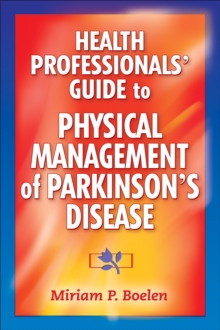Health Professionals Guide to Physical Management of Parkinsons Disease is also available as an e-book.
The e-book is available at a reduced price and allows readers to highlight and take notes throughout the text.
When purchased through the Human Kinetics site, access to the e-book is immediately granted when the order is received. Parkinsons disease, the most prevalent hypokinetic movement disorder, is expected to occur with increasing frequency among aging populations worldwide.
While we await the discovery of a cure, combining physical interventions with traditional medical interventions can significantly improve overall quality of life.
Health Professionals Guide to Physical Management of Parkinsons Disease fills a void in this area of clinical management by comprehensively addressing the physical management of Parkinsons disease in a single volume. Written for clinicians, Health Professionals Guide to Physical Management of Parkinsons Disease will prove to be a useful resource for physical therapists as well as other health care professionals who manage patients with Parkinsons disease.
The text expertly distills and blends diverse research-based sources with the authors own extensive clinical experience.
The result is a concise manual that provides not just the science but also the clinical application necessary in the selection of physical interventions. The text begins with an introduction to Parkinsons disease and the umbrella of care required in the management of patients, giving readers a clear explanation of medicinal, surgical, assisted, and self-management strategies depending on the stage of disease.
After laying this groundwork, the text continues by focusing on two types of dyskinetic movements: dystonia (which can influence posture) and tremor. Also reviewed is the use of supportive devices and adaptive equipment to minimize the effects of dystonia and tremor.
The discussion moves on to balance deficits (Hoehn and Yahr stage 3), transfer problems, and the neurologic and musculoskeletal impairments that contribute to them.
The text concludes with a qualitative and quantitative assessment of gait and includes specific treatment guidelines addressing characteristic gait problems. Health Professionals Guide to Physical Management of Parkinsons Disease is an easy-to-navigate reference for clinicians who do not have the time or the need to read a book cover to cover, but want answers fast.
The chapters are written as independent units extensively cross-referenced, and they can be read in any order.
Throughout the text, readers will find clinical decision trees, flow charts, and sample forms to guide their selection of intervention strategies.
The book contains many user-friendly features: Numerous illustrations demonstrate exercise considerations, evaluative techniques, and guidance on implementing interventions.
The 11 reproducible handouts address safety and compensatory strategies to improve mobility in patients.
Access to a variety of patient help featuresincluding case examples specific to chapter topics and instructions for handling problemsengage readers and put answers within fingertip reach. With new research showing exercise to be beneficial in delaying the onset of the physical impairments caused by Parkinsons disease, this is a timely resource that will make clinical practices more productive, improve patient outcomes, and advance the treatment of patients with Parkinsons disease.


